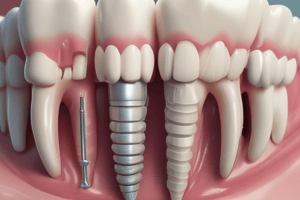Podcast
Questions and Answers
What is the primary component of the periodontium?
What is the primary component of the periodontium?
- Alveolar bone
- Periodontal ligament
- Cementum
- Gingiva (correct)
What is the term for the distance between the gingival margin and the junctional epithelium?
What is the term for the distance between the gingival margin and the junctional epithelium?
- Junctional epithelial depth
- Clinical attachment loss
- Gingival sulcus (correct)
- Probing depth
Which of the following is a characteristic of biofilm-induced gingivitis?
Which of the following is a characteristic of biofilm-induced gingivitis?
- Loss of attachment and apical migration of JE
- Radiographic evidence of bone loss
- Recession of the gingival margin
- Inflammation confined to gingiva (correct)
What is the recommended probing force for periodontal tissues?
What is the recommended probing force for periodontal tissues?
What is the formula for calculating the percentage of bleeding on probing (BOP) score?
What is the formula for calculating the percentage of bleeding on probing (BOP) score?
What is the definition of a healthy periodontium in terms of bleeding on probing?
What is the definition of a healthy periodontium in terms of bleeding on probing?
What is the definition of periodontitis in terms of clinical attachment loss?
What is the definition of periodontitis in terms of clinical attachment loss?
What is the term for the process by which the junctional epithelium migrates apically?
What is the term for the process by which the junctional epithelium migrates apically?
Flashcards are hidden until you start studying
Study Notes
Periodontium
- Consists of four components: gingiva, cementum, periodontal ligament, and alveolar bone
- Gingiva is the mucous membrane that covers the jawbone and surrounds the base of the teeth
Clinical Attachment Loss (CAL)
- Refers to the loss of attachment between the tooth and the surrounding tissues
- Measured from the cementoenamel junction (CEJ) to the base of the pocket
Healthy Periodontium
- Characterized by a normal sulcus (0 to 3mm) with the junctional epithelium (JE) attached to the CEJ
- No evidence of bone loss or inflammation
Biofilm-induced Gingivitis
- Inflammation confined to the gingiva, no evidence of bone loss
- Characterized by a false pocket (hypertrophied gingiva), oedema, redness, and loss of architecture
Periodontitis
- Characterized by true pocket formation, loss of attachment, and apical migration of the JE
- Radiographic evidence of bone loss, recession may be detected
Probing Force
- A light probing force of 25 g is used when probing the periodontal tissues, equivalent to the force required to blanch a fingernail
Bleeding on Probing (BOP) Index
- Used to assess the presence or absence of bleeding in each quadrant
- Calculated as a percentage score for the whole mouth: % BOP score = (Number of surfaces with bleeding x 100) / (Total number of teeth x 6)
Case Definitions
- Healthy periodontium: BOP < 10%, PPD ≤ 3 mm, CAL: No (intact), Radiographic bone loss: No (intact)
- Gingivitis: BOP ≥ 10%-30% (localized), > 30% (generalized), PPD ≤ 3 mm, CAL: No (intact), Radiographic bone loss: No (intact)
- Periodontitis: Interdental CAL ≥ 2 in non-adjacent teeth, or Buccal or Oral CAL ≥ 2
Studying That Suits You
Use AI to generate personalized quizzes and flashcards to suit your learning preferences.



